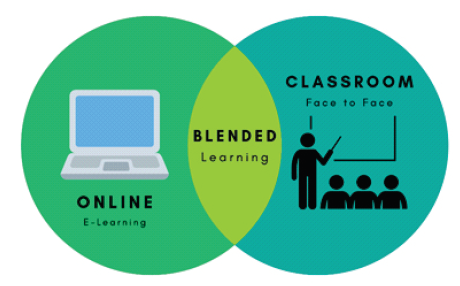What is blended learning and how does it work?
Image: https://www.tp.edu.sg/sii/individuals/blended-learning
Blended learning as an approach is not new. Indeed, the practice of combining (blending) different learning
approaches and strategies is not new. Distance learning courses have long combined blended learning through a mix
of self-access content (print/video/TV/ radio) and face-to-face/telephone support. 'Traditional' courses have always
combined (and some still do) a variety of delivery modes that combine content such as lectures, seminars, tutorials,
workshops and group work to give learners a range of learning opportunities. And of course, 'good teachers will
always use more than one method or approach in their teaching, and good learners will always combine different
strategies in their learning' (Marsh, 2012:3*).
So we could say that the term 'blended learning' refers to every time teachers mix different media (e.g. print, audio,
and video) with classroom interaction, maximising authentic input in order to support learners' output and skills
development. As such, blended learning has more or less always existed, although the term itself is a mere 15 years
old at most, and is now understood to mean a rich, supportive learner-centred learning environment where the 'right
blend' is synonymous with effective learning (and teaching).
What is new is that today, technology combines all the different media within one environment: online. The online
space facilitates learner–learner interaction, encourages incidental and exploratory learning and allows learners and
teachers to stay connected outside the classroom, if they so wish. Learners can benefit from the fact that space and
distance do not matter any more. Teachers and educationalists are now understanding more and more that, with the
'right blend', teachers can offer a much richer, supportive learning environment, learning opportunities increase,
learning becomes more effective and the learning process becomes more enjoyable.
There are many definitions for blended learning, but they all have the following in common: they refer to two
different learning environments — face-to-face (synchronous) and online (asynchronous); and they refer to combining
those two learning environments in a complementary way to deliver a programme of study so that learners can be
supported both within the classroom environment and outside of it. In other words, the term blended learning refers to
any programme of study that is delivered by appropriately combining both synchronous interactive study (usually
face-to-face) and asynchronous (individual) study (usually online).
We could go further and say, 'It's in the blend!' That is, the key to a successful blended learning approach is to use the
strengths of each medium appropriately, combining the two different learning environments in an integrated way so
that each medium complements one another: the classroom environment being used for what it does best, such as
introducing new topics, explaining important language points or for meaningful communicative activities, and the
online environment being used for what it does best, such as preparing for the next topic (by watching a video/reading
a text, etc.), and/or practising and consolidating what has been learnt in class or for extra practice. Both modes of
delivery put the learner at the centre of the learning process.
(…)
*Marsh, D. Blended Learning:Creating Learning Opportunities for Language Learners. Cambridge: Cambridge University Press, 2012.
(Adapted from: KING, A. Blended language learning: Part of the Cambridge Papers in ELTseries. [pdf] Cambridge: Cambridge University Press, 2016, p. 2.Available
st at: http://languageresearch.cambridge.org/cambridge-papers-in-elt Accessed on October 31, 2019).


